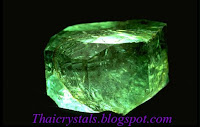Olivine, of which peridot is a type, is a common mineral in mafic and ultramafic rocks, and it is often found in lavas and in peridotite xenoliths of the mantle, which lavas carry to the surface; but gem quality peridot only occurs in a fraction of these settings.
Peridot olivine is mined in North Carolina, Arizona on the San Carlos Reservation, Hawaii, Nevada, and New Mexico, in the US; and in Australia, Brazil, China, Kenya, Mexico, Myanmar (Burma), Norway, Pakistan, Saudi Arabia, South Africa, Sri Lanka, and Tanzania.
In much antique jewelry, peridot could have come from Egypt: in the late 18th/early 19th century, peridot was taken from Egyptian ecclestial and other ornaments and reused in jewelry. Furthermore a location in Egypt was (re-) discovered but its location remains unknown.[3]
The largest cut peridot olivine is a 310 carat (62 g) specimen in the Smithsonian Museum in Washington, D.C..

Custom Search

















































